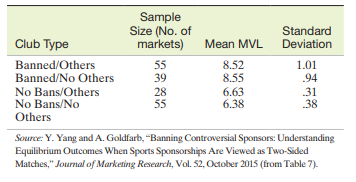Banning controversial sports team sponsors. Successful marketing of professional sports franchises involves finding sponsors that appeal to the team’s fans. The Journal of Marketing Research (October 2015) published a study that investigated the impact of banning a controversial sponsor (e.g., one that manufactures an alcoholic beverage) on a soccer team’s success. Data were collected for 43 English soccer clubs over a 30-year period, where each club-year represents a market. The clubs were divided into four types: (1) clubs that had banned alcohol sponsors but now have other sponsors, (2) clubs that had banned alcohol sponsors and now have no other sponsors, (3) clubs that did not have banned alcohol sponsors but now have other sponsors, and (4) clubs that did not have banned alcohol sponsors and now have no other sponsors. To assess the impact of an alcohol ban in a market, the researchers computed the matching value loss (MVL), a numerical measure used to estimate the value lost between a club and a sponsor if a ban is implemented. The table below gives summary statistics for the matching value loss for the four club types in 177 markets. The mean matching value losses of the four types were compared using an analysis of variance. Although the ANOVA table was not provided in the article, sufficient information is provided to reconstruct it.

a. Compute SST for the ANOVA, using the formula (see p. 532)
![]()
where ![]() Â is the overall mean MVL of clubs in all 177 mar Kets.
 is the overall mean MVL of clubs in all 177 mar Kets.
b. Recall that SSE for the ANOVA can be written as

c. Use the results from parts a and b to construct the ANOVA table.
d. Is there sufficient evidence (at a = .01) of differences among the mean market value losses of clubs in the four types?
e. Comment on the validity of the ANOVA assumptions. How might this affect the results of the study?
"Looking for a Similar Assignment? Get Expert Help at an Amazing Discount!"


